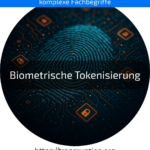Biometric tokenisation is particularly at home in the fields of cybercrime and cybersecurity, digital transformation, e-commerce and digital commerce. This term refers to a particularly secure method of protecting personal data such as fingerprints or facial recognition when we want to identify ourselves or pay online, for example.
Instead of storing the original biometric image, a special process converts these unique features into an encrypted code - the so-called token. This token cannot be recalculated so that no one can deduce the original biometric feature from the code. This increases security in the event that data is stolen.
An illustrative example: You pay in an online shop and use your facial recognition on your smartphone for confirmation. The shop or payment service does not receive your real facial image, but only a token that is only valid for this one transaction. Even if this token is intercepted, it is useless because it cannot be turned back into your face and is only valid for this one transaction.
Biometric tokenisation therefore not only makes online processes such as payment or logging in more convenient, but also significantly more secure.






